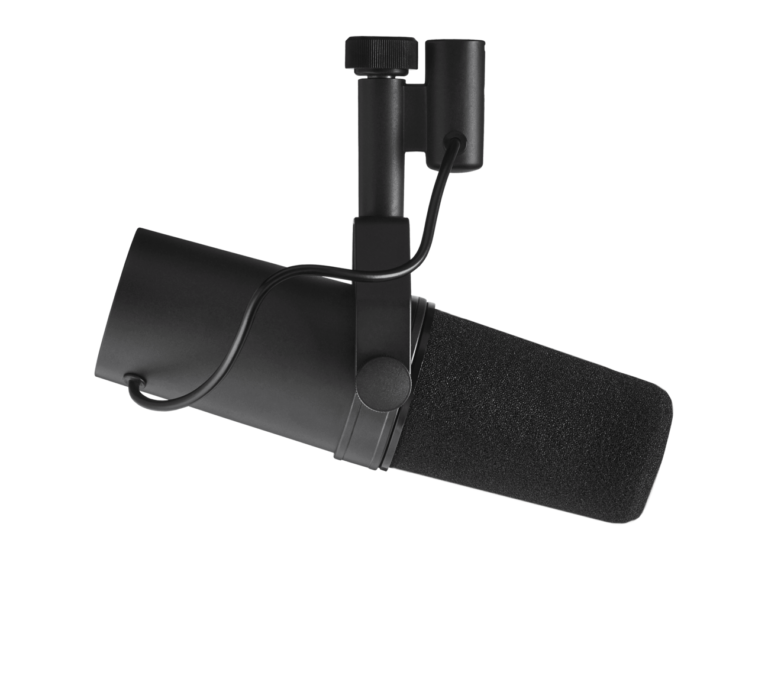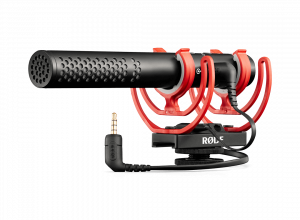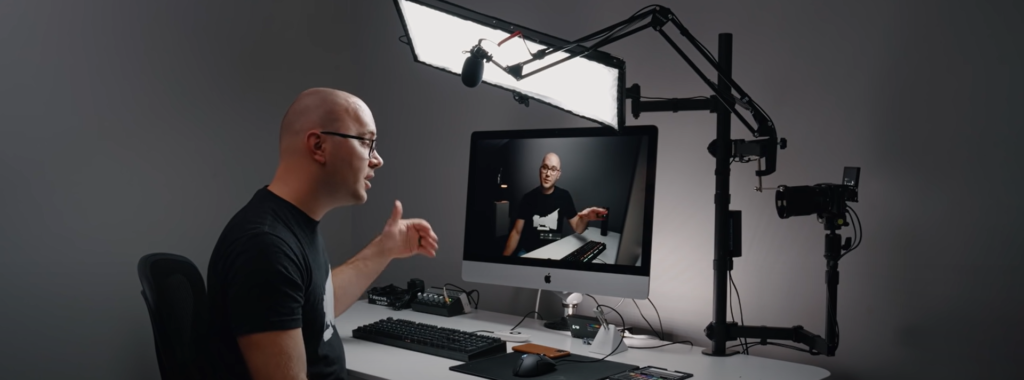Shotgun Microphones ~
These days, it seems that unless one uses the venerable Shure SM7B microphone, one is not a bona fide podcaster or YouTuber.
So you need an SM7B? If you’re looking at purchasing gear to record screencasts, the answer is probably “No”. But before I get into my reasons, let’s get back to the basics for a moment.

The purpose of the narration or the voice over in a screencast is to instruct, explain or provide context. And the goal should be high intelligibility and low auditory fatigue for the learner/viewer.
The microphone you acquire will depend on whether you want the microphone to appear in the video frame. The SM7B is a dynamic broadcast mic and, ideally, this mic should be positioned no more than 15 cm (6 inches) from the speaker’s mouth. Consequently, it’s virtually impossible to keep this mic out of the frame. Yet for many Youtubers, nothing screams “take me seriously” more loudly than an SM7B that’s visible in the video frame.
Now that the SM7B is out of the way, the rest of this post will focus on candidate microphones for when one does not want one to appear in the frame.
Option 1 is to use a wireless lavalier (lapel) mic like the Rode Wireless Go ii. Why wireless? Because I’ve used a wired lavalier mic in the past, and on more than one occasion, I had absent-mindedly gotten off my chair after recording, and attempted to walk away from my desk while still tethered to the audio interface. Needless to say, stuff came crashing onto the floor.
Option 2 is to use a shotgun mic. Shotgun mics are used in filmmaking where it’s often attached to a boom pole and the boom operator holds it aloft out of the frame but still close enough to capture the talent’s voice cleanly. What’s special about a shotgun mic? A shotgun mic’s narrower field of coverage reduces the amount of background noise being picked up. And shotgun mics almost invariably use a condenser capsule that makes them more sensitive than dynamic mics and thus can be placed about 45-100 cm from the speaker’s mouth, allowing it to be kept out of the video frame. If you’d a more detailed explanation of microphones, here’s the link to a post I wrote on the subject some years ago – https://bit.ly/3J73D0N.
There’s a huge variety of shotgun mics in the market with correspondingly large differences in quality, features and price. But for the purposes of screencasting, we can look at a small subset. I’ll use three models from Rode as examples, and I’ve listed them in ascending order of price.
I cite Rode gear as examples because they are high quality and reasonably priced. Furthermore, Rode is an Australian company that manufactures most of its products in Australia.
The Rode VideoMic Go ii is the lowest cost of the three and is a great starter mic for screencasters. Mount it to a desktop mic boom arm connect a USB cable to the mic and your laptop or tablet and you are cooking with green hydrogen. Additionally, Rode has a free app called Rode Connect that provides users with quite a few options for tailoring their sound.
While one can connect the VideoMic Go ii to a camera via a cable with 3.5 mm jacks, run-and -gun filmmakers will be probably better served by the VideoMic NTG because it comes with a built-in amplifier that allows one to increase the output levels thus easing the load on the camera’s mic preamp, making for cleaner (less hissy) sound in many cases (depending on the brand and model of your camera). Like the cheaper VideoMic Go ii, this model also supports audio over USB, and works with the Rode Connect software.

Finally, for those of you who want a more refined sound and either already own an audio interface with 48V phantom power or are willing to buy one, you might like to check out the Rode NTG 5. Be warned that you are now entering territory of diminishing returns because there are shotgun mics costing many multiples of the NTG 5.
So why the fuss over mics and audio quality when it comes to recording screencasts? Because a filmmaker friend once told me, “Video is 80% audio.” To illustrate his point, he reminded me that many of us have lost ourselves in a movie on a VHS tape when the audio quality was good. And the converse is true – 4k video is a turn off when the audio is bad.
So if you want to create learning products that facilitate learning, remember to pay attention to sound quality.
Watch this space for a companion post on using dynamic microphones for creating learning products.
p.s. The bannner image shows Caleb Pike (DSLR Video Shooter) at his excellent screencasting workbench. Learn how to build one at https://youtu.be/WedG8LKO6ks
#edtech #elearning #onlinelearning
